Old Gold Mine Hermitage Offers Rural Retreat Space
For Monastics, Dedicated Lay People, in Washington
Written by: Roger Fox
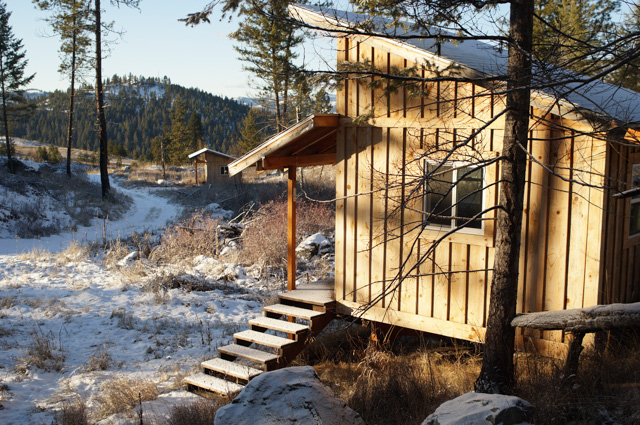
The two primitive kutis share a beautiful view of the Kettle River Mountains.
Photos by: Khemako Bhikkhu (Roger Johnson), Taan Dan, Roger Fox, Taan Peter, Taan Saulo
Ten years after its founding, Old Gold Mine Hermitage continues to provide isolated retreat space for individuals in the extreme northeast corner of Washington state.
The name reflects the fact that there’s an old gold mine shaft on the 40-acre property, but more deeply points to the hope that retreatants staying here are mining for true gold, that which is to be found in the dhamma.
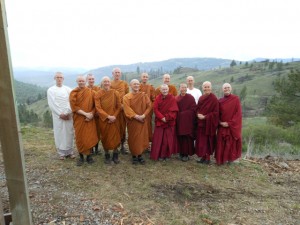
Monks and nuns visited to plant trees on the property in the spring of 2014.
Old Gold Mine Hermitage offers four solitary kutis (cabins), for monastic and lay retreats. The first of these is modern except there is no toilet. It has running hot and cold water, a shower, electric heat and a kitchen with a refrigerator, microwave, toaster oven and an electric hot plate. It also has a sleeping loft and panoramic views of the mountains and valleys.
The other three kutis are “primitive,” in that they only have electric heat, lighting and a hot plate. There is a sink but water jugs must be carried in. They also have sleeping lofts and are situated in a forested valley.
Supporting these four is a central building with a full kitchen, a bathroom with a shower, and laundry facilities. The building also houses the altar room and communal library.
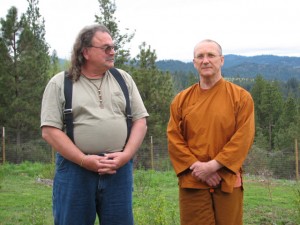
Roger Fox with Ajaan Pasanno Bhikkhu, abbot of Abayagiri Monastery in California.
Every winter the hermitage hosts monks from Metta Forest Monastery south of Los Angeles, the seat of my primary teacher, Ajahn Thanissaro. Several of these monks have been here 10 times, and have spent as many as seven weeks on retreat.
The hermitage also has hosted several long-term lay retreatants. One young man was in retreat for two years, another for 18 months and a third for a full year. Many others have completed retreats of one to three months.
Limited cell phone and Wi-Fi services are available for necessary transactions. Their use is not encouraged at the hermitage for obvious reasons.
The hermitage has several miles of dirt roads and pathways for walking and is surrounded by many thousands of acres of wilderness, much of which is National Forest and not crossed by anything other than off road-trails. The walking, hiking, and meditative opportunities are limitless.
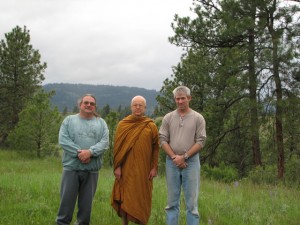
Roger Fox on the left with Ajaan Thanissaro in the middle and Brian Johnson (Khemako Bhikkhu) on the right. Ajaan Thanissaro is abbot of Metta Forest Monastery, outside San Diego.
Monastics or clergy wanting to stay at Old Gold Mine Hermitage need to contact me and affirm that they are legitimately ordained in their religious traditions. After that we are available purely on a first-come first-served basis.
Lay retreatants need to provide a reference or referral from a recognized teacher in their tradition, stating they have sufficient training and will benefit from a silent and secluded retreat.
Retreats at the hermitage are free, although I do accept donations to help in the running and further development of the hermitage. Retreatants will be expected to pay for their food and a small daily energy use fee of $1 or $2 per day, depending upon the season.
Other financial arrangements can usually be made for monastics and clergy who have taken a vow of poverty.
Weather at the hermitage can be a bit unpredictable as we are in the Kettle River Mountains near the small town of Republic, just 25 miles from the Canadian border and about 75 miles from Idaho.
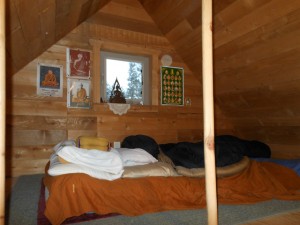
The sleeping loft of the “modern” cabin, the most outfitted of the three.
Typically summer temperatures range from the low 40s Fahrenheit to the upper 90s. Winter will be from -10 degrees to the low 30s.
Snowfall starts in November and continues through early May. Snow accumulation averages 5 feet and precipitation in the form of rain amounts to about 8 inches for total yearly precipitation of 15 inches.
During 2015 we experienced record-breaking dry weather through the summer with the worst fire season in recorded history. Although the hermitage was spared direct fire damage it did suffer many weeks of extreme smoke. Often visibility was less than 100 yards and the sun was nothing more than an orange-red blob in the sky.
Two major fires, Northstar and Kettle Complex, came within 5 miles of the hermitage. This follows a bad fire season in 2014, a major wind storm in 2012, and a fire on the hermitage property in 2010 that burned many trees but no buildings.
A Response To A Need
I first envisioned Old Gold Mine Hermitage in 1998, shortly after being introduced to the Theravadin tradition in Buddhism. I made an immediate connection with the teachings of the Western-born monk Thanissaro Bhikkhu, and realized there was a need for places in the West where Buddhist forest monks could follow their traditional path of living in the jungles and forests while still being supported by lay Buddhists.
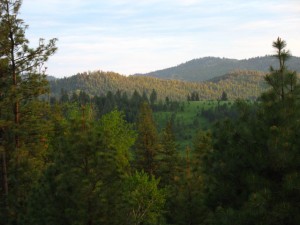
The view over the region has been somewhat compromised by wildfires.
The forests are quickly disappearing in Southeast Asia, but people in the U.S. West, with its vast stretches of wilderness, had little to no knowledge of the support needed for Buddhist monastics to prosper. I decided early on that this is what I wanted to do; provide this environment for monastics.
In 2004, while living at Metta Forest Monastery in San Diego County, I met Brian Johnson while I was preparing to search for land on which to establish my dream. We decided to work together and we broadened the scope of the “hermits” the hermitage would serve to include a very select number of lay persons, as well as monastics and clergy from all religious traditions. The only requirement would be a sincere and deeply abiding belief in one’s tradition.
Johnson ordained as a monk in 2011, and is now residing as Khemako Bhikkhu at Wat Abhayagiri, near Redwood City, California. He no longer has any connection with the operation of Old Gold Mine Hermitage, although he visits when he can.
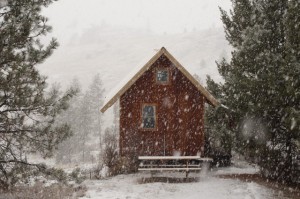
Snow falls over the hermitage.
My practice follows the lineage of Ajahn Mun, Ajahn Lee, Ajahn Fuang, and then through my teacher Ajahn Thanissaro, an American with many years in Buddhist robes.
Ajahn means teacher or one with many years in robes. I also have connections with Ajahn Pasanno, a monk of the Ajahn Chah lineage who is abbot of Wat Abhayagiri, California.
We at the hermitage also have developed a connection with the Tibetan nuns from Sravasti Abbey near Spokane. In 2014 some of them came to the hermitage and helped plant 1,000 pine trees, helped by monks from Abhayagiri and some Friends of the Dhamma from the Portland, Oregon area.
I have found great joy and peace developing and maintaining the hermitage over the last decade. The hard work of infrastructure construction with limited assets and manpower are the greatest challenge, as I look into the future of Old Gold Mine Hermitage.
May all beings live happily, free from animosity.
May all beings share in the blessings springing from the good I have done.
